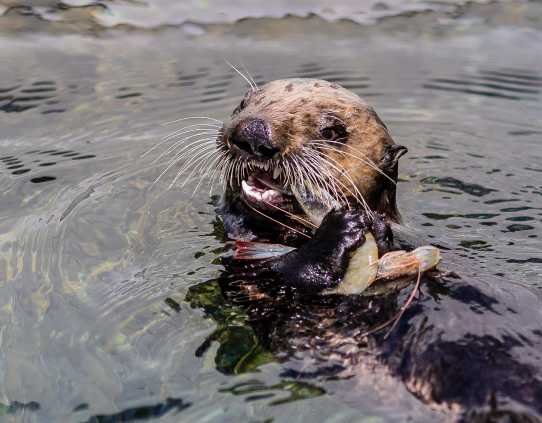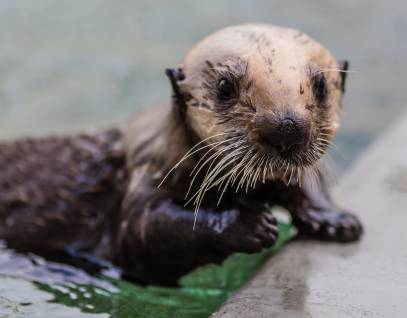
Sea Otter Pup Langly Orphaned Due to Great White Shark
- Species conservation
Before her death, Langly’s mom was able to get her pup to shore, where the response team at The Marine Mammal Center stepped in to give the orphaned otter a second chance at life.
Volunteer responder Tony Salome’s notes from the mother-pup sea otter rescue on May 7 are gut-wrenching:
After a brief assessment, it appeared as though mom had suffered shark bite injuries and expelled a lot of energy getting her pup safely to shore. Her pup was vocalizing loudly as it clung to mom. Plan A was to net both animals together. We anticipated mom would fight to protect her pup, but she had no strength left and it was the pup who fought to protect her mom.
The rescue team from the Center was able to successfully net both sea otters and crate them for transport to our hospital. But unfortunately, the pup’s mother had suffered extensive shark bite wounds that caused her to lose a lot of blood. She died on the way to the Center’s triage facility less than 30 miles away.
Bites from great white sharks, likely the cause of Langly’s mother’s death, are one of the top causes of mortality in this threatened species and seem to be a factor limiting the southern sea otter’s recovery throughout California. Although the sharks do not usually eat sea otters—researchers believe they mistake them for seals, a preferred meal—the initial taste-test bite is often lethal to the otter.
When the newly orphaned sea otter pup arrived at our clinic, veterinarian Dr. Heather Harris gave her an initial admit exam and noted that she was in good body condition with no obvious injuries—her mother had likely protected her from the shark!
The sea otter pup, named Langly by rescue volunteers, was alert, active and feisty—all good signs that she had a fighting chance of survival, but was she old enough to make it without mom? By looking closely at Langly’s body size, fur condition and teeth, Dr. Harris found good news: Langly was close to weaning age, meaning she would soon be switching from mom’s milk to a grown-up sea otter diet of scallops, crabs, shrimp and other crustaceans, and had likely been eating some of these foods already. Dr. Harris determined that Langly was a good candidate for rehabilitation. That meant it was now up to the animal care experts at the Center to help Langly make the full transition to solid food.
During her first month at the Center, Langly lost a little weight due to the abrupt loss of her mother’s nourishing milk as well as low appetite and a little difficulty figuring out how to crack open her shellfish meals on her own. Animal care volunteers diligently prepared meals for Langly six times a day, cracking mussels and clamshells and removing crab and shrimp legs, to make the transition to solid food easier for her.
Meet Langly
Southern sea otter pup Langly was orphaned when her mother received a fatal bite from a great white shark. Luckily, her mother was able to get Langly safely to shore where our trained responders were able to rescue her.
Sprout, a sea otter pup suffering from domoic acid toxicity, came to our hospital not long after Langly arrived. The two young otters formed a strong bond and spent much of their time swimming and playing together as they regained their health.

Langly Gets a New Pen-Mate
Langly’s overall strength and appetite have improved over the last two months, and she especially perked up once we were able to introduce her to a companion, an otter of similar age that was rescued by the Monterey Bay Aquarium.
Langly’s new pen-mate stranded in Monterey in February at just a few months old, much too young to survive without her mother. She was starving, had a severe parasite infection, was unable to keep herself warm, and was also suffering from seizures. Test results showed that she had been exposed to the biotoxin domoic acid, which can cause damage to the heart and brain.
After spending four months of intensive rehabilitation at Monterey Bay Aquarium, her health had greatly improved and the opportunity to move her into a pool with another young female seemed like it might benefit both young otters. In mid-June, she was transferred to the Center to provide companionship for Langly with a goal of eventually releasing them back to the wild together. The two young otters formed a strong bond immediately. They remain very attached to each other and interact constantly.
Thanks to our supporters, over the last 20 years, the Center has been leading research efforts to better understand domoic acid toxicity in marine mammals. Most of the research has been with California sea lions but also threatened species, such as Guadalupe fur seals and, more recently, southern sea otters. While this young otter is in our care, we’ll use diagnostic tools like magnetic resonance imaging (or MRI) to help us learn more about this disease and how it affects sea otters.
Learn More About Our Work With Sea Otters
{"image":"\/Animals\/Patients\/Sea otters\/2017\/cropped-images\/so-otto-by-dana-angus-c-the-marine-mammal-center-usfws-permit-ma101713-1-134-0-2714-2120-1666384028.jpg","alt":"southern sea otter Otto","title":"Otter Conservation Efforts Bolstered By New Rehabilitation Space","link_url":"https:\/\/www.marinemammalcenter.org\/news\/otter-conservation-efforts-bolstered-by-new-rehabilitation-space","label":"Patient Update","date":"2017-08-31 02:00:00","type":"news"}

Otter Conservation Efforts Bolstered By New Rehabilitation Space
August 31, 2017
Read More{"image":"\/Animals\/Patients\/Sea otters\/2017\/cropped-images\/so-yankee-doodle-by-bill-hunnewell-c-the-marine-mammal-center-usfws-permit-ma101713-1-1-427-2301-1797-1603829308.jpg","alt":"sea otter Yankee Doodle ","title":"Toxoplasmosis Poses Threat for Sea Otters Like Yankee Doodle","link_url":"https:\/\/www.marinemammalcenter.org\/news\/toxoplasmosis-poses-threat-for-sea-otters-like-yankee-doodle","label":"Patient Update","date":"2017-09-06 05:00:00","type":"news"}

Toxoplasmosis Poses Threat for Sea Otters Like Yankee Doodle
September 6, 2017
Read More{"image":"\/Animals\/Patients\/Sea otters\/2021\/cropped-images\/so-spinny-by-bill-hunnewell-c-the-marine-mammal-center-usfws-permit-ma101713-1-542-6-3105-2426-1635880506.jpg","alt":"southern sea otter Spinny","title":"Threatened Southern Sea Otter Found Stranded with His Life at Stake","link_url":"https:\/\/www.marinemammalcenter.org\/news\/threatened-southern-sea-otter-found-stranded-with-his-life-at-stake","label":"Patient Update","date":"2021-11-03 02:00:00","type":"news"}

Threatened Southern Sea Otter Found Stranded with His Life at Stake
November 3, 2021
Read More{"image":"\/Animals\/Wild\/Sea otter\/cropped-images\/sea-otter-grooming-pup-shutterstock-0-164-2452-1916-1604511740.jpg","alt":"sea otter mom and pup","title":"Experts Successfully Reunite Sea Otter Pup with its Mother","link_url":"https:\/\/www.marinemammalcenter.org\/news\/experts-successfully-reunite-sea-otter-pup-with-its-mother","label":"Press Release","date":"2019-02-05 04:00:00","type":"news"}

A Third Otter Battles Toxoplasmosis
For the first time since retrofitting our pool areas to provide a rehabilitation space for this threatened species, the Center is caring for three southern sea otters at the same time. Pip, an adult female, was rescued at the end of May suffering from toxoplasmosis, a potentially lethal condition caused by a parasite that primarily affects the brain.
When she first arrived at our hospital, Pip was very underweight and did not behave like a wild sea otter. She was weak and had muscle tremors, and though hungry, had difficulty feeding herself—all signs that the toxoplasmosis was affecting her brain function.
After several weeks of anti-parasite treatment and specialized care, Pip is showing improvement in both her neurologic function and her activity. Despite being a picky eater that doesn’t like taking her medication—spitting it out if she detects a pill hidden in a shrimp or fish—she has been eating her meals regularly and has re-gained a healthy amount of weight.
She now grooms regularly, which is critical for survival in cold ocean waters, and she swims well and actively resists capture when veterinary staff approach her for check-ups, indicating she still has the instincts of a wild otter.
Returning to the Wild
As all three otters continue to improve during their rehabilitation, the veterinary team is considering putting all three together in one pool to give them more opportunities to socialize.
Once the otters are ready for release, the Center’s veterinarians will implant tracking devices in their abdomens. Because a sea otter’s dense fur is so important to their survival—it’s the only thing keeping them warm in the cold waters off the coast of California—we can’t attach satellite tags to their fur, like we do with some of our seal and sea lion patients.
These advanced tracking devices will help us better understand and protect this threatened species. One is a radio transmitter that will allow us to monitor location and movements from shore to ensure both otters are thriving in the wild. These tags have been used in sea otters for years to track their progress. The other is a Life History Transmitter that will transmit information about the otter’s life via satellite after it dies.
Our hope is that the Center will continue to contribute to the overall scientific knowledge about southern sea otters and the diseases and other threats they face, enabling efforts to restore the population and remove them from the threatened species list.
Yes, I want to save a life!

Yes, I want to save a life!
You’ll be giving sick and injured animals the best possible care at the Center’s state-of-the-art hospital. With your gift today, you are giving a patient a second chance at life in the wild.
See Our Latest News
{"image":"\/Misc\/Graphics\/cropped-images\/climate-change-graphic-giant-earth-shutterstock-1798-6-5113-3994-1680046432.jpg","alt":"An Earth Day graphic of people holding the planet, recycling, planting a tree and moving a solar panel.","title":"5 Ways to Celebrate Earth Day","link_url":"https:\/\/www.marinemammalcenter.org\/news\/5-ways-to-celebrate-earth-day","label":"News Update","date":"2024-04-18 02:00:00"}

{"image":"\/Animals\/Patients\/Hawaiian monk seals\/2024\/cropped-images\/hms-rs10-release-photo-c-the-marine-mammal-center-noaa-permit-24359-0-0-966-755-1712699238.jpg","alt":"Hawaiian monk seal RS10 is released and heads toward the water","title":"Endangered Hawaiian Monk Seal Back Home on Kaua\u02bbi After Receiving Life-Saving Care for Ingested Fishing Gear","link_url":"https:\/\/www.marinemammalcenter.org\/news\/endangered-hawaiian-monk-seal-back-home-on-kauai-after-receiving-life-saving-care-for-ingested-fishing-gear","label":"Press Release","date":"2024-04-09 02:00:00"}

Endangered Hawaiian Monk Seal Back Home on Kauaʻi After Receiving Life-Saving Care for Ingested Fishing Gear
April 9, 2024
Read More{"image":"\/Animals\/Wild\/Sea otter\/cropped-images\/sea-otter-mom-pup-photo-c-brian-simuro-505-0-3387-2646-1618247266.jpg","alt":"sea otter mother and pup","title":"Top Eco Friendly Mother\u2019s Day Gifts that Give Back","link_url":"https:\/\/www.marinemammalcenter.org\/news\/eco-friendly-mothers-day-gifts-that-give-back","label":"News Update","date":"2024-04-08 02:00:00"}

{"image":"\/Places\/Monterey Bay\/cropped-images\/monterey-bay-shutterstock-14-18-4196-3277-1712079225.jpg","alt":"Monterey Bay rocky coastline with blue skies and clouds","title":"Three Key Members Added to Center's Leadership Team with Backgrounds Far Beyond the Ocean","link_url":"https:\/\/www.marinemammalcenter.org\/news\/three-key-members-added-to-centers-leadership-team-with-backgrounds-far-beyond-the-ocean","label":"Press Release","date":"2024-04-02 02:00:00"}

Three Key Members Added to Center's Leadership Team with Backgrounds Far Beyond the Ocean
April 2, 2024
Read MoreHeather S. Harris
Southern Sea Otter


